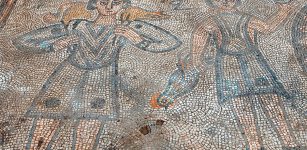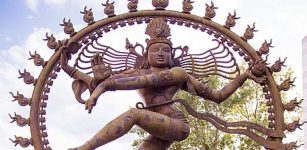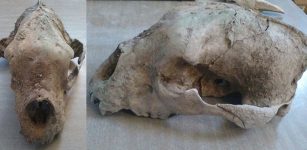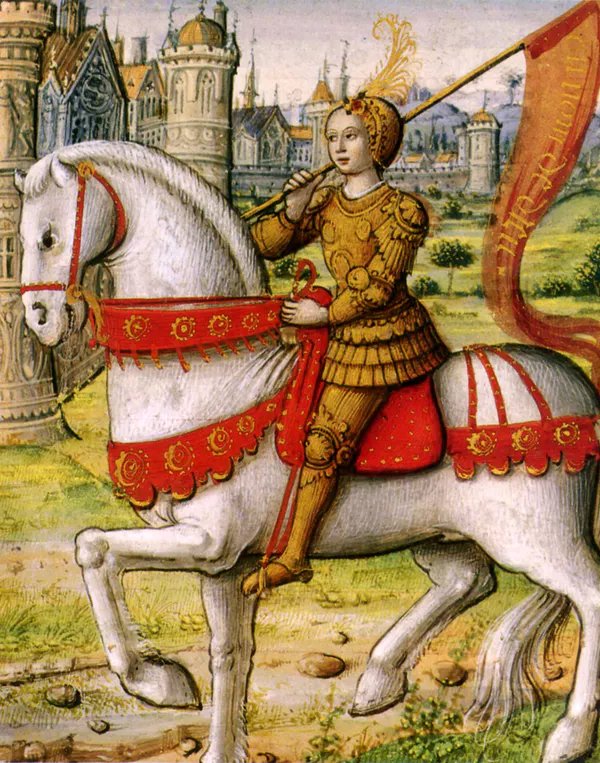Melisandre, The Red Woman: The History Behind Game Of Thrones’ Mysterious Mystic
AncientPages.com - Every Game of Thrones season premiere needs its shock reveal – and season six is no different. As the name of the episode – The Red Woman– hints, this one pertains to red priestess Melisandre, to whom, it turns out, there’s much more than meets the eye (don’t worry, no spoilers ensue). Even in a series known for its complex characters and even more complicated morality, Melisandre and her motives remain surprisingly opaque. And it looks as if her story’s only just getting started.
Helen Sloan / HBO
Admired by some, loathed by others, and feared by many, she was the driving force behind Stannis Baratheon’s claim to the throne of Westeros. She had prophesied that he was Azor Ahai, the champion of the Lord of Light reborn, and, as such, Westeros’ best hope against the coming darkness. Inspired by her prophecies and her mysterious powers, Stannis gave up his faith in the seven gods of Westeros and made her one of his most important advisers.
Although monotheism is probably more familiar to viewers than the polytheistic beliefs held by most of the characters on Game of Thrones, it was hard not to be troubled by Melisandre’s religious message. On one hand her prophecies of the coming of a saviour, a hero from the Lord of Light who will defeat the forces of darkness, will sound familiar to those raised in the Christian tradition. But on the other, her god requires blood sacrifice from his followers, which suggests more sinister rituals. Like Melisandre herself, the motives of her god, R'hllor, remain murky.
These sacrifices were not only condoned but encouraged by Melisandre, who urged Stannis to burn his daughter Shireen in order to ensure his victory. In our history, wars have been fought in the name of God and heretics have been burned for incorrect beliefs. But child sacrifice is usually associated with religious deviants or covens of witches. And indeed, in spite of Melisandre’s own confidence her visions, Stannis’s death at the end of season five suggests that she has either been deceived or misinterpreted the messages sent by her god. Recent revelations suggest that Melisandre may be more of a witch than a prophet.
Shireen’s sacrifice. ©2015 Home Box Office, Inc.
Medieval mystics
The line between between divinely inspired prophet and devilishly influenced witch has always been blurred, especially where women were concerned. The later Middle Ages in particular experienced a flowering of women’s mystical experiences. Although not allowed to become priests, women in this period were increasingly drawn to visions and prophecy and some, like Melisandre, became enormously influential as a result. Bridget of Sweden, for example, successfully campaigned for the papacy to return from Avignon to Rome, and after her death, the account of her revelations circulated widely. The military victories of Joan of Arc made possible the coronation of Charles VII of France and helped bring about the end of the Hundred Years War.
See also:
Can A Huge Ice Wall From Game Of Thrones Exist On Earth?
Wars Of The Roses: Thirty Two Years Of Struggle To Claim English Throne
Murder Of Archbishop Thomas Becket: One Of Most Famous Crimes Of Middle Ages
Knights Templar – Among The Most Wealthy And Powerful Of The Western Christian Military Orders
But if God had messages for the faithful believer, so did the devil and his legion of demonic followers. The difficulty was in telling the difference. Sometimes demons impersonated angels or other holy figures to lead the vulnerable astray. Early theologian John Cassian provides a cautionary example of a monk who, after 50 years of pious living in the desert, is deceived by a demon disguised as an angel and throws himself down a well thinking that he is following a divine commandment. When even the pious are not safe from demonic attack, determining whether inspiration is from God or the devil becomes critical.
Theological writings of the period reveal that women, who were often viewed as physically, intellectually and morally deficient, were considered especially vulnerable to these influences – whether divine or demonic. So a woman claiming to receive special communications from God needed to be especially careful.
Joan of Arc on horseback, 1505 manuscript.
Gods and devils
Before sending Joan of Arc to lift the siege at Orleans, Charles VII ordered that she receive a background check and theological examination. The commission assigned to the task endorsed Joan’s piety, but this didn’t protect her from being accused of sorcery and heresy and then burned at the stake once she was captured by her enemies. And English mystic Margery Kempe was also accused of heresy and frequently needed to explain to clerical authorities the nature of her religious experiences in order to receive their approval.
Having approval was essential for success: with it, a female visionary could have her experiences recorded for posterity and perhaps even become a saint. Without it the best she could hope for was to die unknown (better, at least, than death or imprisonment for heresy).
Melisandre may not need the backing of religious authorities, but she needed Stannis as much as he needed her. Without him to fulfil her prophecies, her faith is shaken. Moreover, even if her message is coming directly from her god, it can be difficult to know how to interpret it. Medieval visionary writings often describe the problems of this next hurdle. The recluse Julian of Norwich contemplated aspects of her visions for 20 years. Even then, she concludes the expanded version of her revelations by stating that, although her work has begun, it has not yet been completed. Completion and full understanding will only be possible in the next life.
Only time can tell if Melisandre’s visions are false, or if she has misunderstood the intentions of her god. But, with her most powerful supporter gone, difficult times lie ahead. Whether she will be accused of sorcery and heresy like Joan, rise to prominence like Bridget, or retreat to seclusion like Julian, remains to be seen.
Written by Marta Cobb - Teaching Fellow in Medieval Studies, University of Leeds
This article is republished from The Conversation under a Creative Commons license. Read the original article.
More From Ancient Pages
-
 Did The Great Sphinx Of Giza Have A Twin And Was It Destroyed By A Lightning Strike?
Featured Stories | Dec 23, 2017
Did The Great Sphinx Of Giza Have A Twin And Was It Destroyed By A Lightning Strike?
Featured Stories | Dec 23, 2017 -
 Battle Of Abrittus: Roman Emperor Decius And His Troops Ambushed And Defeated By Invading Goths
Featured Stories | Jul 1, 2019
Battle Of Abrittus: Roman Emperor Decius And His Troops Ambushed And Defeated By Invading Goths
Featured Stories | Jul 1, 2019 -
 Huge Round Ancient Sewer System Covering 160,000 Square Meters Discovered In Ancient City Of Mastaura
Archaeology | Apr 25, 2022
Huge Round Ancient Sewer System Covering 160,000 Square Meters Discovered In Ancient City Of Mastaura
Archaeology | Apr 25, 2022 -
 Mosaics Discovered In 1,600-Year-Old Church In Mardin Province,Turkey
Archaeology | Sep 22, 2020
Mosaics Discovered In 1,600-Year-Old Church In Mardin Province,Turkey
Archaeology | Sep 22, 2020 -
 Hidden 2,000-Year-Old Roman Road Uncovered In Worcestershire Could Be Of ‘Global Importance’
Archaeology | Nov 12, 2022
Hidden 2,000-Year-Old Roman Road Uncovered In Worcestershire Could Be Of ‘Global Importance’
Archaeology | Nov 12, 2022 -
 Enigma Of Nehushtan – The Biblical Copper Snake
Biblical Mysteries | Oct 31, 2018
Enigma Of Nehushtan – The Biblical Copper Snake
Biblical Mysteries | Oct 31, 2018 -
 Large Earthwork At Wichita Site In Kansas – Is It Long-Lost Native American City Of Etzanoa?
Archaeology | Sep 4, 2020
Large Earthwork At Wichita Site In Kansas – Is It Long-Lost Native American City Of Etzanoa?
Archaeology | Sep 4, 2020 -
 Steamship SS Mesaba Sent Warning To RMS Titanic In 1912 – Her Wreck is Now Identified
Archaeology | Sep 27, 2022
Steamship SS Mesaba Sent Warning To RMS Titanic In 1912 – Her Wreck is Now Identified
Archaeology | Sep 27, 2022 -
 Shiva – Hindu God Who Resides In Every Being And In All Things
Featured Stories | Apr 8, 2019
Shiva – Hindu God Who Resides In Every Being And In All Things
Featured Stories | Apr 8, 2019 -
 Flower Of Life: Ancient Sacred Geometry Symbol And Blueprint Of The Universe
Ancient Symbols | Oct 8, 2017
Flower Of Life: Ancient Sacred Geometry Symbol And Blueprint Of The Universe
Ancient Symbols | Oct 8, 2017 -
 Ancient Genomes Suggest Farming In Africa Was Ignited By Oversea-Migrants From Iberia 7,400 Years Ago
Archaeology | Jun 7, 2023
Ancient Genomes Suggest Farming In Africa Was Ignited By Oversea-Migrants From Iberia 7,400 Years Ago
Archaeology | Jun 7, 2023 -
 Skull And Jaw Of Giant Bear Of The Late Pleistocene Found In Buenos Aires
Archaeology | Mar 15, 2018
Skull And Jaw Of Giant Bear Of The Late Pleistocene Found In Buenos Aires
Archaeology | Mar 15, 2018 -
 History Set In Stone – Maya Rulers Put Their Personal Stamp On Ancient Monuments
Archaeology | Sep 22, 2021
History Set In Stone – Maya Rulers Put Their Personal Stamp On Ancient Monuments
Archaeology | Sep 22, 2021 -
 Early Christian Necropolis Unearthed In Sant’Appianu Cathedral In Sagone, Corsica
Archaeology | Aug 3, 2020
Early Christian Necropolis Unearthed In Sant’Appianu Cathedral In Sagone, Corsica
Archaeology | Aug 3, 2020 -
 Ancient DNA Reveals Irish Are Not Celts – Irish Ancestors Came From Biblical Lands – Scientists Say
Archaeology | Mar 30, 2020
Ancient DNA Reveals Irish Are Not Celts – Irish Ancestors Came From Biblical Lands – Scientists Say
Archaeology | Mar 30, 2020 -
 Fossil Teeth Reveal: Humans Were Present In Asia ‘20,000 Years Earlier’ Than Previously Thought
Archaeology | Oct 15, 2015
Fossil Teeth Reveal: Humans Were Present In Asia ‘20,000 Years Earlier’ Than Previously Thought
Archaeology | Oct 15, 2015 -
 Why Did People Start Eating Egyptian Mummies? The Weird And Wild Ways Mummy Fever Swept Through Europe
Featured Stories | Jun 7, 2022
Why Did People Start Eating Egyptian Mummies? The Weird And Wild Ways Mummy Fever Swept Through Europe
Featured Stories | Jun 7, 2022 -
 Baffling North American Ancient Skulls Contradict Historical Timelines And Mainstream Theories
Ancient Mysteries | Jun 11, 2020
Baffling North American Ancient Skulls Contradict Historical Timelines And Mainstream Theories
Ancient Mysteries | Jun 11, 2020 -
 On This Day In History: William Laud Archbishop Of Canterbury Beheaded – On Jan 10, 1645
News | Jan 10, 2017
On This Day In History: William Laud Archbishop Of Canterbury Beheaded – On Jan 10, 1645
News | Jan 10, 2017 -
 Dian Cécht – Celtic Healer Who Cured Many But Killed His Own Son Of Professional Envy
Celtic Mythology | Sep 19, 2020
Dian Cécht – Celtic Healer Who Cured Many But Killed His Own Son Of Professional Envy
Celtic Mythology | Sep 19, 2020



